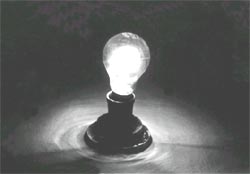Light trap
 light has been slowed to a dead stop, stored and then released as if it were an ordinary material particle. This has been done by two teams of physicists, one led by Lene Vestergaard Hau of the Harvard University and the Rowland Institute for Science in Cambridge, Massachusetts, usa and the other by Ronald L Walsworth and Mikhail D Lukin of the Harvard-Smithsonian Centre for Astrophysics, Cambridge, uk.
light has been slowed to a dead stop, stored and then released as if it were an ordinary material particle. This has been done by two teams of physicists, one led by Lene Vestergaard Hau of the Harvard University and the Rowland Institute for Science in Cambridge, Massachusetts, usa and the other by Ronald L Walsworth and Mikhail D Lukin of the Harvard-Smithsonian Centre for Astrophysics, Cambridge, uk.
Transparent mediums such as water, glass and crystal slow down light slightly. Using a similar but much more powerful effect, the Walsworth-Lukin team first slowed and then stopped the light in a medium that consisted of specially prepared gas containers. In this medium, the light became "fainter and fainter as it slowed and then stopped'. By flashing a second beam of light through the gas, the original beam of light was revived and it left the medium having its original shape, intensity and other properties.
Walsworth-Lukin's team slowed light in a gas form of rubidium, an alkaline metal element. The slowing of the light in the rubidium differed in several ways from how light slows through an ordinary lens. Firstly, light dimmed as it slowed through the rubidium. Secondly, the atoms in the gas developed a sort of impression of the slowing wave. This impression, actually consisting of patterns in a property of the atoms called their spin, was a kind of record of the light's passing and was enough to allow the scientists to revive or reconstitute the original beam.
Hau and her colleagues were able to achieve similar results using almost the same techniques. "The light gets stuck in the medium and it can't get out until the experimenters say so,' said Seth Lloyd, an associate professor of mechanical engineering at the Massachusetts Institute of Technology.
The experiment is a landmark achievement. Lloyd said that the work's biggest impact could come in futuristic technologies called quantum computing and quantum communication. Both concepts rely heavily on the ability of light to carry so-called quantum information, involving particles that can exist in many places or states simultaneously. For both these systems, light is needed to form large networks of computers. But those connections are difficult without temporary storage of light, a problem that can be easily solved if light can be captured.
Two years ago, Nature had published Hau's work. At that time, she had been able to slow light to about 61 kilometres an hour in a system involving beams of light shone through a chilled sodium gas. Walsworth and Lukin mentioned Hau's new work in their paper, saying she achieved her latest results using a similarly chilled gas.
Both Hau's original experiments on slowing light, and the new ones on stopping it, rely on a complex phenomenon in certain gases called electromagnetically induced transparency (eit). This property allows certain gases, like rubidium, that are normally opaque to become transparent when specially treated.
Related Content
- Situation analysis: Covid-19, wildlife trade, and consumer engagement
- Success stories of integrated pest management in India
- Industrial policies for upper-middle-income countries
- Delhi tops the country in fatal road accidents and in number of pedestrians and cyclists falling victim, says new CSE assessment
- CSE assesses air quality and mobility initiatives in Indian cities
- Court Ruling To Shift Greenhouse Gas Fight Back To Congress
